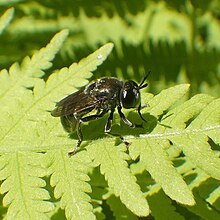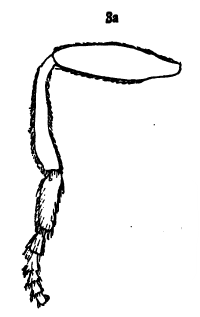Microdon tristis
| Microdon tristis | |
|---|---|
| Scientific classification | |
| Domain: | Eukaryota |
| Kingdom: | Animalia |
| Phylum: | Arthropoda |
| Class: | Insecta |
| Order: | Diptera |
| Family: | Syrphidae |
| Genus: | Microdon |
| Species: | M. tristis |
| Binomial name | |
| Microdon tristis Loew, 1864[1] | |
| Synonyms[2] | |
| |
Microdon tristis is a species of syrphid fly in the family Syrphidae.[2][3][4]
Description
For terminology Speight key to genera and glossary

external link gbif
external image[3]
Head
- Face and frons
- Bronze black, unusually flat and broadened below, not convex above, but convex-retreating below.
- Facial depressions are narrow and gray pollinose.
- The pile is pale brassy yellow.
- There is a nearly triangular polished area above antennae that shines steel blue.
- The transverse depression is deep and narrow.
- Frons is moderately constricted below.
- The posterior ocelli distant.
- The ocellar triangle is long, extends nearly to transverse depression and is connected with the vertical bump.
- Vertical bump is usually rather large and transversely covered with tiny, granular bumps and ridges, with a greenish reflection
- The occiput is greenish black, with pale pile that is more concentrated along the eyes.
- The antennae are black.
- The first segment, the scape, is more or less reddish basally.
- third segment, the flagellum, is longer than the first, widest at basal third, beyond which it curves slightly upwards and narrows to a moderately narrow blunt tip.
- Female face.
- Face about equal in width throughout.
- Frons a little narrowed.
- Facial side depressions wider and joined to broader, more triangular.
- Very densely punctured depressions on either side of lower half of frons.
- Polished area above antennae of females larger than males.
- Vertical bump of female is a little larger.
The thorax
- bronzed or purplish.
- Scutum.
- four to six longitudinal greenish stripes present, sometimes indistinct.
- The pile is brassy yellowish
- Scutellum
- Purplish bronzed, somewhat concave, with a stout, bare spur on either side of the concavity.
- female.
- Pile of the thorax and scutellum is more yellow-brassy.
Abdomen
- The color and texture of the abdomen
- Dull black with glossy brownish black, reddish or luteous sides and apex
- Densely and coarsely punctured, except along margin and apex
- The segments size and color
- Second segment has greenish reflection with shallow depression inside anterior angles
- Third segment almost 1.75 times longer than second, slightly depressed basally and inside posterior angles
- Fourth segment longer than first three combined, with lateral depressions and less densely punctured laterally and apically.
- V-shaped depression of the fourth segment is usually indistinct or entirely wanting.
- Second segment has greenish reflection with shallow depression inside anterior angles
- The pile
- Brassy yellow on first two segments
- Light-colored pile on lateral and posterior margin of third segment and on posterior two-thirds of fourth segment
- Shorter and black pile elsewhere
- Light-colored pile may sometimes extend entirely across posterior margin of fourth segment
- Description of the female abdomen
- Female pile on sides of abdomen golden brassy
- Fourth and fifth segments are of about equal length
- Black pilose areas on base of fourth segment, emitting a broad median and narrow lateral black pilose areas
- Female pile on sides of abdomen golden brassy
Wings

- The first posterior ceil (r4+5) has a stump of a vein from the third longitudinal vein ( R4+5).
- This stump of vein is at or slightly beyond the middle of the first posterior cell in the male, but before the middle in the female.
- The wings are lightly infuscated, and darker along the veins.
- The apical crossvein (M1), is recurrent and joining the third longitudinal ( R4+5) vein before the tip of the second vein..
- The squamae is tinged with yellow, the border and fringe of the same color.
- Halteres pale yellow.
Legs

- Mainly blackish.
- Coxae, trochanters, and bases of femora are reddish.
- The tibiae are usually reddish or sometimes just reddish basally and apically.
- The tarsi are similar in color but highly variable.
- Pile
- Mostly whitish yellow.
- More golden under the tarsi.
- The inside of the front tibiae is golden dorsally. [5]
key to adults and pupae north of Mexico. includes head drawing of M. tristis [6]
References
- ^ Loew, H. (1864). "Diptera Americae septentrionalis indigena. Centuria quinta". Berliner Entomologische Zeitschrift. 8: 49–104. doi:10.1002/mmnd.18640080105. Retrieved 11 July 2021.
- ^ a b "Microdon tristis Report". Integrated Taxonomic Information System. Retrieved 2019-09-23.
- ^ a b "Microdon tristis". GBIF. Retrieved 2019-09-23.
- ^ "Microdon tristis species Information". BugGuide.net. Retrieved 2019-09-23.
- ^ Williston, S.W. (1887). "Synopsis of the North American Syrphidae". Bulletin of the United States National Museum. 31: 1–335.
 This article incorporates text from this source, which is in the public domain.
This article incorporates text from this source, which is in the public domain.
- ^ Thompson, F.C (1981). "Revisionary notes on Nearctic Microdon flies (Diptera: Syrphidae)". Proceedings of the Entomological Society of Washington. 83: 725–758.
